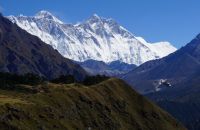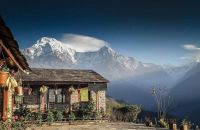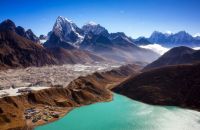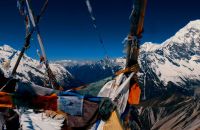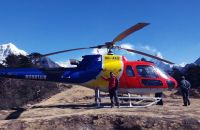Talk with our local travel specialist who can help organize your trip.
Plan Your Manaslu Trek: Must Known Facts & Sights
The Manaslu Trek is an adventurous journey through the remote and stunning landscapes of the Himalayas, offering trekkers a unique and less-crowded alternative to popular routes like Everest or Annapurna. This trail circles around Mount Manaslu, the eighth-highest peak in the world, showcasing breathtaking mountain views, rich cultural experiences in traditional Tibetan villages, and diverse ecosystems.
From navigating the challenging Larkya La Pass to discovering hidden monasteries, the trek combines adventure with cultural immersion. In this guide, you'll find essential information, including the best times to visit, required permits, must-see sights, and practical tips to help you plan and enjoy your Manaslu Trek to the fullest. Whether you're an experienced trekker or a first-timer, this journey promises an unforgettable Himalayan experience.
These include more specific concerns such as the physical fitness required for the trek, potential altitude sickness and its prevention, alternative trekking routes within the Manaslu region, as well as the availability of tea houses and lodges along the trail. Trekkers also frequently inquire about transportation options to and from the trailheads, local customs and etiquette in the remote villages, and how to best prepare for the weather conditions that can vary significantly throughout the trek.
Furthermore, topics like trekking insurance, the cost of hiring a guide or porter, and the environmental conservation practices in the Manaslu region are commonly discussed. These additional considerations help trekkers gain a more comprehensive understanding of the experience, ensuring they are fully prepared for the challenges and rewards of the Manaslu Trek
Table of Content
1. Electricity and internet access on the Manaslu Trail
Teahouses offer access to wife for a fee. NTC (Nepal Telecom) sim has better coverage than Ncell along this route. However, the signals get weaker as you gain elevation, and you can only use your phone to send messages. Internet is available only till Samagaon. After crossing the Larkya La, it’s possible to get internet connectivity at Dharapani.
Electricity is available on the trail. While the villages at the lower elevations are connected to the national grid, the hamlets at the higher elevations depend on solar power or micro-hydroelectric projects for their power supply. You can expect power cuts and low voltage at the higher elevations. If the weather remains cloudy, those teahouses that are dependent on solar energy may be left without any power. Therefore, it’s advisable to carry a power bank or a portable solar power charging unit with you while trekking. Teahouses usually charge USD 3 or 4 per hour for wifi and for charging your electronic devices.
2. Transportation
From Kathmandu, there is road access to the trailhead. This eliminates the worry of having to take a perilous flight on a tiny aircraft across the mountains to get to the trailhead. You can take a public bus, hire a private taxi, or ride on a shared Jeep to get to the trailhead. The drive to the trailhead from Kathmandu takes about seven or eight hours.
3 Food and Drinking Water
Teahouses offer simple meals like the Nepali staple food of daal-bhaat (rice, lentil soup, vegetable curry, and pickles), momo (dumplings), chowmein (fired noodles), Tibetan bread, Indian flat bread or chappati, bread toast, porridge, etc. You can get hot or boiled water by paying extra. Most food items are expensive on the trail, as these have to be transported by porters or mules from the towns that lie far away from the trail. Mineral water bottles are available for purchase at the teahouses. But these may cost four or five times more than the original retail price.
For drinking water, you can carry a reusable water bottle with a filtration system like Steripen. Or you can purchase some water purification pills and use them to purify the water. It is advisable not to drink water directly from open sources like streams and rivers. Filter your water properly before using it for drinking.
4 Expenses and Payment Options at Teahouses
Manaslu trail lies in a remote corner of the country. Most of the days you will be cut off from modern civilization while trekking. There are no banks or ATMs, big shops or stores en route. Teahouses will be the only places where you can spend some money buying drinks, snacks and food. Since teahouses do not accept card payment or payment in foreign currency, you need to have local currency with you to buy items on the trail.
Only local currency or Nepalese rupee is accepted at shops and teahouses on the trail. Therefore, before you set off from Kathmandu, make sure to withdraw enough local currency (30 to 40 thousand will be enough) from any of the local bank’s ATMs. ATMs in Nepal usually accept Visa, Mastercard, and American Express cards. Apart from purchasing food and drinks not included in your trekking package cost, you will need local currency to pay for charging your electronic devices (phone, camera battery, power bank, etc), hot showers, tipping (porter and guide at the end of the trek), mineral water, hot water, etc.
5 packing List
The agency you will book your trek with will send you a comprehensive list of gear and equipment that you will need during your trek. Apart from the weather-appropriate clothing and gear do not forget to pack your documents with you (passport, Nepal visa, permits, etc.). Gear and equipment are readily available for purchase as well as hire at shops in Kathmandu, if you feel doubtful about the quality of stuff available in Nepal then you can bring your trekking gear from your home country.
The agency you will book your trek with will send you a comprehensive list of gear and equipment that you will need during your trek. Apart from the weather appropriate clothing and gear do not forget to pack your documents with you (passport, Nepal visa, permits, etc.).
Gear and equipment are readily available for purchase as well as hire at shops in Kathmandu, if you feel doubtful about the quality of stuff available in Nepal then you can bring your trekking gear from your home country.
For crossing over Larkya La you will certainly need crampons and gaiters to navigate the snow-covered pass. You should also not forget to pack a few rolls of toilet paper while packing for your trek as toilets at the teahouses tend to be rustic with no indoor plumbing.
Featured Trips
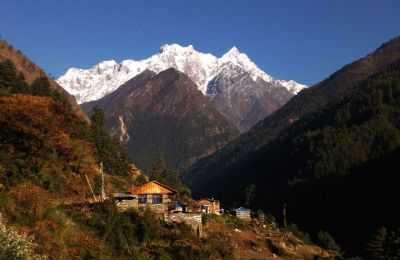
Manaslu Circuit with Tsum Valley Trek - 24 days
Manaslu Circuit with Tsum Valley trek in the off-beaten path of northwestern Nepal witnesses remote village lifestyle while circling the eighth highest mountain of the world. The 24 days long trek traverses to the beautiful Annapurna and Manaslu region to explore the rich wilderness and hidden valleys.
Inquire Now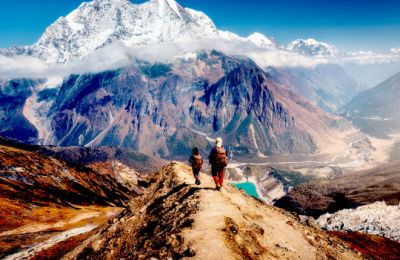
Short Manaslu Circuit Trek via Arughat - 14 days
Short Manaslu Circuit Trek via Arughat is best for those looking to witness all of the wonders the Manaslu region offers in the quickest way to complete Manaslu Circuit in 14 days.
Inquire NowWhere to travel next?
Get help from our travel specialists for holiday ideas that matches your interests.
6 Travel Insurance
Travel insurance is mandatory on this trek. You should take a policy that covers costs for high-altitude air rescue and evacuation. Some travel insurance policies do not offer coverage for injuries and evacuation services at high altitude, so you should read the fine print carefully before buying your insurance. You should choose one that offers coverage for high-altitude rescue and evacuation above 5000 meters.
Fascinating Places and Detours on the Manaslu Circuit
Tsum Valley
Tsum Valley, accessible as a detour from the Manaslu trip, is one of the unexplored gems of the Nepal Himalaya. In order to protect the valley's fragile ecology and culture, the Nepali government banned outsiders from visiting Tsum; therefore, the valley remained totally isolated. Tsum Valley wasn't made accessible to visitors until 2008. Previously, there was even a restriction on the free movement of Nepalese citizens from other regions into the area.
Tsum Valley, which is near Tibet and the Ganesh Himal range, has a seemingly timeless ambience. Tsum Valley is home to ancient Buddhist monasteries and nunneries that are repositories of ancient Tibetan Buddhist knowledge and culture. The valley's sensitive cultural history and close proximity to Tibet have led the authorities to decide to accord restricted zone status to the area and keep foreign influences out of the region.
There are two distinct areas in the Tsum Valley: Upper Tsum and Lower Tsum. The valley is home to thirty-three communities in all. The valley's residents speak a dialect known as Tsumke or Tsumba. The Tsum Valley is unique in that, all creatures, including birds and insects, are safeguarded and permitted to coexist without human intervention. There are numerous fascinating, valley-specific Buddhist customs observed by the valley’s thirty-three communities. For instance, the culture of'shyagya’.
The people of Tsum live according to the "Shyagya" culture. They have embraced the Buddhist practice of 'shyagya’, which means "a tradition of non-violence." As per the 'shyagya’ culture, hunting and killing wild animals, collecting honey, trading animals or their parts, destroying trees and setting fire to forests, and capturing or killing birds, animals, or insects are forbidden in the valley. Locals regard Tsum Valley as a beyul, a sacred haven blessed by Guru Rinpoche where all living beings have the right to exist.
Milarepa Cave, or Piren Phu, Mu Gompa, and Rachhen Gompa are some of the cultural attractions of Tsum Valley. If you wish to visit this fascinating place, you can include an excursion of Tsum Valley in your Manaslu Trekking itinerary.
Nubri Valley
The Manaslu trail weaves across the culturally rich Nubri Valley. Like the Tsum Valley, Nubri Valley is deeply ingrained in Tibetan Buddhist customs and culture. Some of the area's oldest monasteries may be found in the Nubri Valley. The valley encompasses the villages of Bhi, Samagaon, Prok, Tsak, Samdo, Lhi, Li, Sho, Shayala, Namrung, Ghap, Shak, and Gyayul. In the past, the Nubri Valley is thought to have been a part of the Ngari empire of Western Tibet.
Following the Nyingmapa branch of Tibetan Buddhism, the people living in the Nubri Valley have a unique tradition of allowing lamas to marry. Known as Ngakpas, the married lamas are allowed to perform priestly duties at homes and at the monastery.
The Pungyen Gompa, located at an elevation of 4050 meters, is one of the ancient and important monasteries in the Nubri Valley. The monastery lies between the Nubri villages of Shayla and Samagaon. The monastery is more than four hundred years old and was built by the first settlers in the Nubri Valley. The monastery is named Pungyen after the Nubri name for Mount Manaslu. Locals of Nubri Valley call Manaslu, Pungyen, or Kutang.
The Nubri Valley's residents occasionally travel to Tibet for trading and to get essentially supplies. As Tibet lies closer to their villagers than Nepal’s towns and cities, the villager finds it easier to get stuff from across the border. Goods are transported to Nubri Valley from Tibet using yak caravans.
Featured Trips

Short Manaslu Circuit Trek via Arughat - 14 days
Short Manaslu Circuit Trek via Arughat is best for those looking to witness all of the wonders the Manaslu region offers in the quickest way to complete Manaslu Circuit in 14 days.
Inquire Now
Short Manaslu and Tsum Valley Trek - 19 days
Experience the Short Manaslu and Tsum Valley Trek, a 19-day adventure through sacred, secluded valleys in Nepal. Explore the hidden Buddhist paradise of Tsum Valley, ancient monasteries, and the majestic Manaslu and Ganesh Himal.
Inquire NowWhere to travel next?
Get help from our travel specialists for holiday ideas that matches your interests.
Manaslu Base Camp, Birendra Taal, and Rui La
You get to hike to the base of Mount Manaslu during the Manaslu Trek. With an elevation of 8,163 meters, Manaslu is the eighth highest mountain in the world and one of the world's fourteen eight thousanders. From the historic village of Samagaon, a quick climb brings you near Manaslu Base Camp (4,900 m), where you can take in the breathtaking sight of the snow-capped peak.
The people of the area revere Mount Manaslu, also known as the "Spirit Mountain," and regard it as their protector deity. In the communities living at the base of the mountain, it is completely forbidden to kill or injure any living thing, including birds, animals, and insects, as doing so would pollute this sacred place and invite the wrath of the mountain deity.
En route to the Manaslu Base Camp, one comes across the breathtaking mountain lake, Birendra Taal. The mountains coated in snow encircle the turquoise lake. The sight of the azure lake encircled by snow-capped mountains is breathtaking.
Mountaineering groups attempting to summit Mount Manaslu encamp in tents around the base camp during the busiest climbing season. Although the peak is not as large as Mount Everest, experienced climbers claim that reaching the summit of Mount Manaslu is far more difficult and trickier. Other mountains that you can see in close proximity from the Manaslu Base Camp are Himalchuli, Naike Peak, Ganesh Himal, and Shringri Himal.
Another excellent place for day hiking is Rui La (4998 m), a steep mountain pass at the border between Nepal and Tibet. The hike to Rui La pass begins from Samdo village. The trail is remote and isolated, and there are no settlements for miles along the Rui La Pass trail. The lonely mountainside is home only to yaks and yak herders. Rui La also marks the trading route, and one can see yak caravans traveling to and fro from the border area.
The border between Tibet Autonomous Region of China and Nepal is marked by a stone at the summit of Rui La Pass. The nearest Tibetan village lies about a day’s walk from Rui La pass. After walking for two days, one will reach one of Tibet’s highways.
Manaslu Conservation Area and Annapurna Conservation Area
The Manaslu trekking trail takes you across two nature conservation areas, which are rich reservoirs of Himalayan wildlife and vegetation. The Manaslu Conservation Area is a 1663-square-kilometer conservation park. The Manaslu Conservation Area protects the habitats of the Snow Leopard, Himalayan marmot, Himalayan tahr, blue sheep, black bear, lynx, and musk deer, among other species.
Over two thousand plant species and over a hundred bird species can be found in the protected area. Eleven different kinds of wood can be found here, along with six different climate zones: arctic, subarctic, temperate, tropical, and alpine. This area is one of the Himalayas' hotspots for the richest biodiversity because of the variance in climate.
A total of 7629 square kilometers makes up the Annapurna Conservation Area Project in the Annapurna Region. Within the conservation area, one will find 1226 species of wildflowers, 518 rare birds, and 105 species of mammals. The world's largest rhododendron forest is found in this nature conservation park, high on the foothills of the Annapurna Range.
Final Note
Trekking in the Himalayas and experiencing cultural magnificence are best combined on the Manaslu Trek. The journey transports you into an untamed environment with verdant jungles and steep mountain passes. You can stroll through historic villages filled with ethnic groups that have not had much interaction with outsiders. The unspoiled scenery, rich culture, challenging trek, and fascinating interactions with the local mountain people will undoubtedly leave a lasting impression on you.
For a genuine cultural experience and unspoiled Himalayan landscape, the Manaslu Trek is the best option. Additionally, the trail is less touristy and congested. You will see indigenous groups who continue to live as their ancestors did. The captivating views of Manaslu, the eighth-highest mountain in the world, Singri Himal, Himalchuli, and Ganesh Himal is another reason to choose this trek. If Manaslu Trek is on your bucket list, we urge you to do it. Hopefully, you will find the information given above helpful in Planning a Manaslu Trek in Nepal.
- Written by: Naba Raj Amgai
Updated: Oct, 24, 2024







